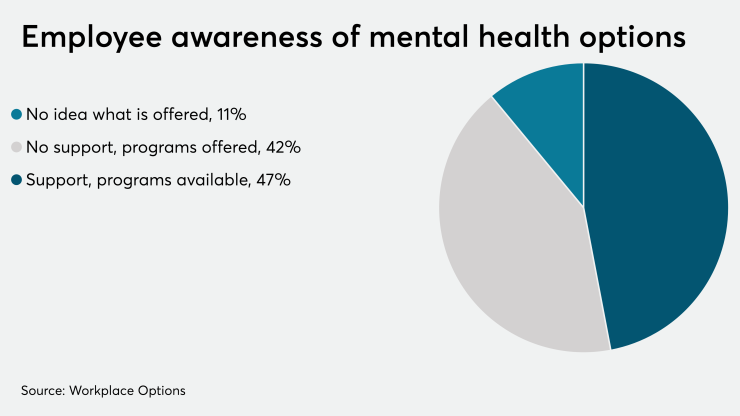What keeps your employees from showing up for work every day: Flu? Bad back? Car trouble?
Not if your workforce is typical of U.S. employees. The fact is, nearly two-thirds of missed work days can be attributed to mental health conditions.
Mental health issues in the workplace are much more prevalent — and more serious — than you might think — and Mental Illness Awareness Week (Oct. 6–12) is a great time to think about it. Mental illness is one of the top causes of worker disability in this country, and recent Unum research with employers and employees on mental health in the workplace showed 62% of employees felt mentally unwell at some time in the past year. Even more startling: Among those diagnosed with a mental health issue, 42% have come to work with suicidal feelings.
This type of presenteeism — where employees try to battle through despite their symptoms — can affect the productivity, work quality and morale of your entire team. Not only are those suffering less effective, their co-workers are likely confused and concerned about the behaviors they’re seeing.
The good news is there’s a lot you and your company can do to help.
Mental illness can cover a wide range of conditions. Anxiety disorders are the most common, affecting 40 million adults. They’re highly treatable, yet only 37% of those suffering receive treatment.
Depression — one of several mood disorders that also include seasonal affective disorder and bipolar disorder — is a leading cause of disability worldwide. About 16 million people live with major depression.
But mental health concerns aren’t limited to employees who’ve been diagnosed with a mental illness. Health, finances, personal family relationships, and job satisfaction are all triggers that affect workers’ mental well-being, according to Unum’s survey. Even supposedly “happy” events — getting married, having a baby — can cause tremendous stress.
Many employers — hopefully your company is one — offer mental health resources to their employees to better handle illness and everyday stresses. These can include medical care, employee assistance programs, counseling referrals, and financial and legal counseling.
So far, so good. The problem, however, is a major gap between what HR professionals say they offer and what resources employees are aware of.
For example, 93% of employers in Unum’s survey say they offer an EAP — but only 38% of employees realize they have this benefit. Similarly, 90% of employers say their company medical plan includes mental health resources, but only 47% of employees know that. And a quarter of employees surveyed say they’re not aware of any mental health resources at all.
One reason for the lack of understanding about mental well-being resources is the social stigma attached to mental health, and it’s not just among workers: Unum’s survey showed 61% of employees feel there’s a stigma in workplace, and 51% of HR professionals agree. And nearly half of both groups say the stigma has stayed the same or gotten worse in the last five years, despite national public campaigns to normalize the conversation about mental wellness.
Most employees (81%) say the stigma associated with mental health issues prevents employees from seeking help. Many of those struggling keep their issues secret for fear of discrimination, reputational problems or job loss. Sadly, more than a quarter don’t disclose their mental issue to their employer because they’re ashamed.
What you can do to help
There are many ways you and your company can open the conversation about mental well-being and provide the resources your employees need to be productive and effective.
- Communicate with your workforce regularly about mental health resources available to them. Mental Illness Awareness Week (Oct. 6–12) and
World Mental Health Day (Oct. 10) offer great opportunities to talk about the topic. Give these resources the same promotion as your other benefits. - Encourage senior leaders to participate in the conversation about mental well-being. Showing top-down support helps create a more open, accepting environment.
- Educate managers about symptoms of mental health issues and how to accommodate employees who need help.
- Consider the full range of your benefits, beyond health care. For example, financial stress is one of the top factors affecting mental well-being. If you don’t already, consider offering financial planning services or counseling to help employees better plan for their future needs. Benefits such as disability insurance and life insurance — even voluntary coverage that employees pay for themselves — can provide peace of mind and help ease a financial burden during a stressful time.
- Offer flexible work schedules, including work-at-home arrangements to help employees create better work-life balance.
- Learn more about mental health issues and solutions, including more tips and best practices for your workplace. Unum’s recent Mental Health Report is a good place to start.






